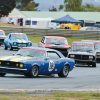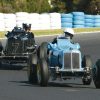LaFerrari – Official Press Release and Photos
The wraps are finally off the LaFerrari. The Prancing Horse’s eagerly-anticipated limited-series special, of which just 499 will be built, made its world debut today at the Geneva International Motor Show.
“We chose to call this model LaFerrari,” declared Ferrari’s President, Luca di Montezemolo, “because it is the maximum expression of what defines our company – excellence. Excellence in terms of technological innovation, performance, visionary styling and the sheer thrill of driving. Aimed at our collectors, this is a truly extraordinary car which encompasses advanced solutions that, in the future, will find their way onto the rest of the range, and it represents the benchmark for the entire automotive industry. LaFerrari is the finest expression of our company’s unique, unparalleled engineering and design know-how, including that acquired in Formula 1.”
For Ferrari the development of a limited-series special like the LaFerrari represents an opportunity to experiment with all the technological solutions that will later filter down onto the production cars. Of particular significance in this context is the introduction of the hybrid system which, making full use of the Scuderia Ferrari’s F1 KERS know-how, has resulted in a solution that exalts Ferrari’s fundamental values – performance and driving thrills. The hybrid technology used, known as HY-KERS, represents the perfect combination of maximum performance and lower emissions. LaFerrari in fact emits just 330 g/km of CO2 but without resorting to electric-only drive which would not fit the mission of this model. The HY-KERS system is, however, designed so that in future applications a car can be driven using exclusively electric power for a few kilometres and, during development testing, a full-electric version of LaFerrari achieved just 220 g/km of C02 emissions on the combined cycle.
The LaFerrari is equipped with dynamic controls that are integrated for the first time ever on a Ferrari road car with active aerodynamics and the HY-KERS system. Thanks to Ferrari’s proprietary logic which govern all the systems, the car can achieve absolute levels of performance, aerodynamic efficiency and handling without any form of compromise in any area. A very advanced and uncompromising approach was also taken with the interior design which features an HMI inspired by F1 single-seaters.
Architecture
The LaFerrari’s architecture posed the first challenge for the Prancing Horse team at the planning stage of the design. The aim was to achieve ideal weight distribution (59% at the rear) and a compact wheelbase despite the extra bulk of the hybrid system. The result is that all of the masses are situated between the car’s two axles and as close as possible to the floor to lower its centre of gravity (by 35 millimetres) and thereby guarantee dynamic handling and compact dimensions.
The layout of the cabin made a significant contribution in this regard. The seat is fixed and tailored to the driver while both the pedal box and steering wheel are adjustable. The driving position is similar to that of a single-seater and was designed after consultation with the Scuderia Ferrari drivers, Fernando Alonso and Felipe Massa, who played an active role throughout the entire development process.
The LaFerrari’s chassis features no less than four different types of carbon-fibre, all hand-laminated and autoclave-cured in the racing department using the same design and production methods as the Formula 1 car. This helped optimise the design: various functions were integrated (e.g. seats and battery compartment) into the chassis to improve torsional rigidity (+27%) and beam stiffness (+22%) whilst cutting weight.
Powertrain
The LaFerrari is the first car in Ferrari history to be powered by the HY-KERS system. The ICE represents the pinnacle of engine development and research, with a 6262 cc V12 that punches out 800 CV and revs to a maximum of 9,250 rpm, a record for an engine of this displacement. It also features a very high 13.5:1 compression ratio and a high specific output equal to 128 CV per litre. The engine is coupled with a 120 Kw (163 CV) electric motor, giving it a combined power output of 963 CV.
The high torque levels available at low revs from the electric motor allowed the engineers to optimise the internal combustion engine’s performance at higher revs, thus providing a constant supply of exceptional power throughout the rev range. Total torque generated is in excess of 900 Nm. The hybrid system is composed of two electric motors developed in collaboration with Magneti Marelli – one powering the driven wheels and the second the ancillaries – and a battery pack attached to the floor of the chassis consisting of cells that are assembled in the Scuderia Ferrari department where the KERS for the F138 is also made. The Scuderia’s expertise allowed considerable savings in weight and size of the individual components and the batteries weigh just 60 kg while providing the highest energy density possible for this kind of application.
The batteries are charged in different ways: under braking (even hard braking with the ABS active) and every time the V12 produces more torque than required, such as in cornering. In the latter instance, rather than the being sent to the wheels, the excess torque is converted to energy and stored in the batteries.
The electric motor is coupled with the F1 dual-clutch gearbox to the benefit of optimal weight distribution, but also to boosting energy efficiency as torque is instantly available to the wheels and, vice versa, from the wheels to the electric motor in recharging.
Aerodynamics
Active aerodynamics play an essential role, as they allow a complete adjustability of the car’s configuration to attain LaFerrari’s exceptional performance.
The engineers’ aim was to deliver the highest degree of aerodynamic efficiency ever achieved with any road car, with a coefficient of nearly 3, thanks to technical solutions honed with CFD analysis and fine-tuned in the F1 Wind Tunnel.
To boost efficiency, the LaFerrari sports active aerodynamic devices front (diffusers and guide vane on the underbody) and rear (diffusers and rear spoiler) which generate downforce when needed without compromising the car’s overall drag coefficient. These devices deploy automatically on the basis of a number of different performance parameters which are monitored in real time by the car’s dynamic vehicle controls, thus guaranteeing the ideal configuration on the basis of the driving conditions.
Control systems
One further innovative aspect of the LaFerrari is the integration of its active aerodynamics and hybrid system with the other dynamic control systems aboard. This means the car responds intelligently to driver inputs, making for a seamless blend of unprecedented performance and unparalleled driving emotions.
Proprietary Ferrari algorithms deliver optimal integration of the electric motor and V12 for instantaneous response. In cornering, for instance, the HY-KERS keeps the V12’s revs high to guarantee better acceleration on exit.
The LaFerrari’s Brembo braking system is also integrated with the hybrid system, and incorporates several new features, including new lightweight callipers designed to guarantee correct cooling and carbon-ceramic material (CCM) discs featuring a new composition.
The car’s extreme performance potential called for a different tyre set-up, with 265/30 R 19 Pirelli P-Zeros on the front and 345/30 R 20s on the rear.
All in all the car guarantees maximum driving thrills in every situation and performance levels are top level: 0-100 km/h in less than 3 seconds and 0-200 km/h in under 7 seconds, a lap time at Fiorano of under 1’20” – 5 seconds faster than the Enzo and over 3 seconds faster than the F12berlinetta. LaFerrari is thus the fastest road car in Maranello’s long history.
Styling
The Ferrari design team led by Flavio Manzoni developed the LaFerrari’s styling working in close synergy with the engineers to emphasise the exacting link between form and function. The result is an extreme, innovative design which retains close links to the marque’s tradition. This is most evident in its side profile: the car has a sharp, downward-sloping nose and a very low bonnet which emphasises its muscular wheelarches, a clear nod to the gloriously exuberant forms of late-1960s Ferrari sports prototypes.
The LaFerrari’s body has been given a sculptural treatment heavily influenced by its clearly F1-inspired aerodynamics and a tail section that exudes uncompromising sportiness.
Inside there’s a newly-designed steering wheel sporting all the major commands, and the gear-shift paddles are now longer and more ergonomic. The signature bridge on which the F1 gearbox functions are clustered has taken on a sleek, suspended wing-like shape. The whole interior, in fact, has a fiercely track-inspired, pared-back allure.
[Source: Ferrari SpA]
McLaren P1 – Official Press Release and Photos
The race-inspired Instant Power Assist System (IPAS) gives the McLaren P1 astonishing performance. Zero to 100km/h will take less than 3 seconds, zero to 200 km/h under 7 seconds, and zero to 300 km/h will be achieved in no more than 17 seconds. Putting that into perspective, that’s 5 seconds faster than the legendary McLaren F1 road car. Top speed is electronically limited to 350 km/h.
McLaren has been engaging with potential customers actively in the last few months to get their views on the McLaren P1, about the car’s styling. Their unanimous verdict on the styling was not to change the car presented last September in Paris. So unusually, the McLaren P1 has translated to production form with very little change. In fact just one, the addition of LTR ducts ahead of each of the front wheels to further aid cooling and optimise downforce.
McLaren has closely monitored demand so as to maintain exclusivity, and announced a production number of just 375 units – a figure that will ensure the McLaren P1 will remain a rarity and, if spotted on the road, an unforgettable sight.
McLaren has also announced that the car will cost from £866,000 on the road with a specification that fully equips the car for both road and track use. The company prides itself on designing performance cars that their owners can use regularly so the McLaren P1 comes comprehensively equipped as standard with an array of colour and trim alternatives from which the customer will be able to choose as well as visible carbon fibre in the cabin. The options list is limited to only bespoke content that a customer might wish to add through McLaren Special Operations, and fitted luggage.
As already announced, the McLaren P1 will have the combined force of two highly-efficient powerplants, offering the optimum mix of superb throttle response, day-to-day drivability and top speed. A mid-mounted 3.8-litre twin-turbo V8 petrol engine is substantially enhanced featuring, for example, larger turbochargers and a highly effective electric motor, to give a combined output of 916PS (903 bhp) and a maximum torque figure of 900Nm. This ensures instantaneous throttle response through the rev range, more akin to a naturally aspirated engine. Emissions of less than 200g/km on the combined cycle are reduced to zero in full electric drive mode, while the Formula 1-derived DRS and IPAS technologies offer an increase in straight-line speed and an instant boost of power.
The tyres fitted to the McLaren P1 are specially developed P Zero Corsas, which have been developed with McLaren’s technology partner, Pirelli. The team at Pirelli has been involved throughout the entire development programme, and this has seen the tyre testing phase integrated into the schedule, as a key performance component. The final compound and construction has been developed and optimised during testing, and the end result is a tyre that is finely tuned specifically to the performance and handling characteristics.
To rein in the power produced by the twin powerplants, the McLaren P1 is designed to offer braking performance more associated with a GT3 or sports racing car. Developed by McLaren’s Formula 1 partner Akebono, the system features a new type of carbon ceramic disc, which has previously seen service in space, but never before used on a road car. Stronger than conventional carbon ceramic, the material dissipates heat more effectively, giving the highly efficient braking system exceptional stopping and cooling capability. The system also boasts significantly reduced weight, and a bespoke ceramic layer coats both friction surfaces to give an attractive mirrored finish.
One surprising feature is that the car can also be driven solely in electric mode. In city driving, with an average speed of 30 mph, this could mean up to a 20km range. More than enough for an owner to enter, for example, a city centre Zero Emissions Zone, have dinner and return home.
[Source: McLaren]
Porsche 911 GT3 – Official Press Release and Photos
The sportiest 911 will have its world premiere at the Geneva International Motor Show: the new Porsche 911 GT3. In the 50th anniversary year of the 911, Porsche is now set to open a new chapter in race track performance sports cars. The fifth generation of the 911 GT3, a complete new development, will take the pole position among the thoroughbred Porsche sports cars with naturally aspirated engines. Boxer engine and transmission, as well as body and chassis are completely new and constitute a further development of the 911 GT3 concept with an impressive performance leap. Power: 475 hp. Power to weight ratio: 3.0 kg/hp. Acceleration from zero to 100 km/h: in 3.5 seconds. Top speed: 315 km/h. Lap time Nürburgring Nordschleife: under 7:30 minutes. As a technical highlight, it features the first active rear wheel steering in a production Porsche. As well as the optional full LED headlights. The new 911 GT3 keeps all the successful properties of a sports car suitable for racing, with even more driving dynamics, more sophisticated practicality – and a highly emotional fun factor.
The powertrain of the new 911 GT3 is composed of a 3.8-liter boxer engine yielding 475 hp (350 kW) at 8.250 rpm, a Porsche dual-clutch transmission (PDK) and a high-traction rear-wheel drive. The six-cylinder engine is based on the same engine as the 911 Carrera S, although they share only few common parts. All other components, particularly the crankshaft and valve gear, were specially adapted or designed for the GT3. For instance, Porsche designed titanium connecting rods and forged pistons. The basic modifications set the stage for an extremely high-speed engine that reaches up to 9.000 rpm. The Porsche dual-clutch transmission was also specially developed; the characteristics are directly based on a sequential gearbox from motor racing, thereby providing further performance and dynamics advantages to the driver.
For the first time, Porsche is using active rear wheel steering in order to achieve even higher precision and lateral dynamics. Depending on the speed, it steers in the same or opposite direction of the front wheels, improving stability and agility. Other new modules improving driving dynamics are the electronically controlled, fully variable rear differential lock, and the dynamic engine mounts. The newly developed all-aluminium chassis can still be adjusted by height, toe and camber. Contact with the road is made by the new 20-inch forged alloy wheels with central locking.
[Source: Porsche AG]
Alfa Romeo 4C – Official Press Release and Photos
The global launch of the Alfa Romeo 4C marks the return of the brand to the world of lightweight sports coupés, an extraordinary event, awaited ever more eagerly by the host of fans throughout the world. The exclusive ‘Launch Edition’ was created just for them, a numbered limited edition of 400 in Europe with exclusive characteristics developed specifically for this unique version.
It makes its début today, at the 83rd Geneva International Motor Show, where orders officially opened for the ‘Launch Edition’ of the new 4C compact supercar at a price of 60,000 euros in most European markets (price including VAT net of other local taxes). What’s more, all buyers can take part in an exclusive event which will include an advanced driving course, to learn how to make the most of its potential in complete safety.
The new Launch Edition can ‘clothe’ its body with two liveries – Carrara White or Alfa Red – and is marked out by the distinctive badge, inlaid beneath the paintwork. The line of the special car is enhanced by the carbon aerodynamic kit (including spoiler and door mirror covers), the rear aluminium diffuser with dark finishing, Bi-LED headlights with dark surround and 18″ (front) and 19″ (rear) alloy wheels with burnishing treatment.
To accentuate the sports look still further, there are front air intakes, brake calipers in a specific colour, racing exhaust system with BMC air cleaner and suspension kit with specific calibration for shock absorbers and rear anti-roll bar.
The interior has the same sports feel, with highlights provided by the leather/fabric sports seats with parts in Alcantara, as well as the distinctive, numbered carbon badge. In the case of the red livery, the Alfa Romeo 4C Launch Edition has red stitching on the steering wheel trim, handbrake, mats, handles and sports seats.
Of course, the Alfa Romeo 4C Launch Edition offers all the winning characteristics of the model that represents the essential sportiness embedded in the ‘Alfa Romeo DNA’: Italian style, performance and technical excellence, for maximum driving pleasure in complete safety.
Designed by Alfa Romeo and produced in the Maserati plant in Modena, the new mid-engined rear-wheel drive coupé with two bucket seats will be become available for purchase in 2013 and will mark the return of the Italian brand to the United States, inaugurating Alfa Romeo’s global growth plan.
The Alfa Romeo 4C derives directly from the concept which raised many eyebrows in admiration at the Geneva Show in 2011, so much so that it won three prestigious awards: the ‘AutoBild Design Award’ (2011, Germany), the ‘Design Award for Concept Cars & Prototypes’ (2012, Italy) and the ‘Most Exciting Car of 2013’ – ‘What Car?’ (2013, Great Britain).
Acronym 4C
The acronym ‘4C’ draws its inspiration from the brand’s glorious past, projecting the values of technology and emotions into the future. Indeed, it refers to Alfa Romeo’s great sporting tradition: the acronyms 8C and 6C in the 1930s and 1940s distinguished cars – both racing and non – fitted with the powerful ‘eight cylinders’ and the innovative ‘six cylinders’, confirming in its design layout and construction the goal of achieving the weight/power ratio of an authentic supercar, less than 4 kg/HP, yet focusing not merely on the maximum power delivered, but on limiting the weight to guarantee maximum agility and top performance. To this end, the Alfa Romeo 4C uses state-of-the-art technologies and materials derived from super sports cars (including the Alfa Romeo 8C Competizione) – carbon fibre, aluminium, rear-wheel drive – and technologies from the latest standard models from Alfa Romeo, but updated to enhance the sports appeal of the new car even further. This is demonstrated by the new 1750 Turbo Petrol all-aluminium engine with direct injection, the sophisticated “Alfa TCT” twin dry clutch transmission and the Alfa DNA selector with the brand-new Race mode.
Exterior style
Designed by the Alfa Romeo Style Centre, the 4C immediately brings to mind some of the traditional iconic models which have left a significant mark in the history of the Brand. Above all others, in terms of dimensional and layout similarities, one stands out in particular: the 33 Stradale, a car that combined extreme mechanical and functional requirements with an essential style which “clothed” the engine and chassis appropriately with unmistakable Alfa Romeo treatments.
The 4C has followed suit, and thus completes a journey which was embarked upon with the 8C Competizione, emphasising some particular concepts of the brand, such as compact size, dynamism and agility.
The development of the 4C’s exterior was characterised from the start by the need to enhance the style of the car and the technical characteristics both from a dynamic and aerodynamic point of view. For this reason, all the style solutions adopted have been optimised in accordance with the ultimate goal of the car: performance.
The rear volume, sinuous and enveloping, simultaneously encloses and embraces the beating heart of the car: the mechanics and the engine, visible through the rear window. All this, thanks to the development of marked musculature above the wheels, lends strength and power to the rear end. The rear musculature supports its structure on round rear light clusters and on the side air intakes necessary to cool the intercooler and the air intake for engine aspiration.
From this energy-charged rear volume and the two side air intakes spring the two long muscles which lend speed and dynamism to the side, generating the necessary volume at the front end to house the headlights and, on the central part, the two robust ribs running along the bonnet, tracing the unmistakable “V” and coming to their natural conclusion around the shield.
This, together with the two side intakes, forms the famous “Trefoil”, a substantial facet of Alfa Romeo’s profile.
Interior design
The elemental design and essential materials also distinguish the interior, which is all designed and built for maximum driving satisfaction.
Specifically, the carbon fibre of the central cell immediately stands out in the interior, left in full view to enhance the sense of low weight, technology and uniqueness of the car.
The dashboard and door panels have an “asphalt ” treatment to recall the vocation of the Alfa Romeo 4C, conceived to convey maximum driving sensation from the road.
The seats ensure dedicated sports posture, favouring the driver’s contact with the road without, however, compromising the comfort required for everyday use of the car.
The dashboard, simple and designed to make using functions simple too, reaches its zenith in the concept of extreme driver-orientation, thanks to digital instruments and gear shift controls located on the appropriately shaped steering wheel.
The cockpit, which powerfully suggests the world of motorcycle racing and race cars, brings together all information necessary to drive and control the car.
The information, which is rendered captivating through powerful, high-impact graphics, allows the driver to keep everything under control without distractions from controls that would be superfluous on this type of car.
The pedal unit and footboards for driver and passenger are all made of aluminium and embellish the lower part under the dashboard, highlighting sports character down to the smallest detail.
Dimensions and aerodynamics
The compact dimensions make this car with 2 bucket seats truly unique among its competitors: 399 cm long, 200 cm wide, 118 cm high and with a wheelbase of 238 cm. These dimensions serve both to emphasise the car’s “supercar proportions” and to accentuate its agility. What’s more, owing to the designers’ excellent work, the car achieves maximum aerodynamic efficiency levels, guaranteeing a negative Cz which, as in racing cars, contributes towards achieving increased stability at higher speeds thanks to the aerodynamic downforce.
New direct-injection 240 HP 1750 Turbo Petrol engine
The engine is the beating “heart” of an Alfa Romeo. In this case, it’s the new direct-injection 240 HP 4-cylinder 1750 Turbo Petrol, which was designed with a precise objective: to ensure exceptional performance without sacrificing driving fluidity and use in any circumstances, from the racetrack to the city streets. The Alfa Romeo 4C’s new mid-engine, all-aluminium power unit adopts specific optimised intake and exhaust systems, to enhance both response at low speeds and extension, with the assistance of a crankshaft with eight counterweights. In addition, it boasts cutting-edge technical solutions including direct petrol injection, dual (intake and exhaust) continuous variable valve timing, a turbocharger and a revolutionary scavenging control system that eliminates turbo lag. Torque delivery is generous, with a peak of 350 Nm, 80% of which is available at only 1700 rpm.
Alfa TCT twin dry clutch transmission
The 1750 Turbo Petrol engine is teamed with the Alfa TCT twin dry clutch transmission, which is a genuine benchmark in the category due to its limited weight and extreme speed of activation. The gears can be changed in sequential mode using the “shift paddles” located behind the steering wheel. Compared to the version already adopted on the Giulietta and MiTo models, the TCT on the Alfa Romeo 4C implements next-generation software and features the new ‘Launch Control’ function that optimises all car systems to provide the utmost acceleration possible. What’s more, to ensure the best performance in accordance with the road conditions and driving style, the Alfa TCT adopts optimised operating logic, interacting with the Alfa DNA selector, the braking system, the engine management system and the vehicle stability control system. For example, in automatic mode, the shifting logic differs according to the Alfa DNA setting.
The new Alfa DNA selector with ‘Race’ mode
A specific evolution of the Alfa DNA selector has been developed for Alfa Romeo 4C, which not only features the three standard settings available on other models in the range – Dynamic, Natural and All Weather – but also a fourth mode: ‘Race’, designed to enhance the driving experience on a racetrack even further. It only takes a long press of the selector in Dynamic position to activate it: in this mode, the Alfa DNA deactivates the stability control and anti-slip systems, leaving the driver in full, exciting control. Finally, the full-digital instrument panel with TFT display changes configuration – showing only information relevant to the chosen mode – and colour in line with the Alfa DNA setting: yellow for Race, red for Dynamic, grey for Natural and blue for All Weather.
Solid but lightweight structure
A stiff, strong but light structure is an essential pre-requisite for a high-performance sports car. The same principle inspired the creation of the Alfa Romeo 4C. A state-of-the-art combination of hi-tech materials of extraordinary stiffness and strength, together with a very low specific weight, was selected to achieve this result. In particular, the chassis is a monocoque made entirely of carbon fibre with ‘pre-preg’ technology derived from Formula 1 and adopted only by the most advanced supercars, which weighs only 65 kilograms, inside which a space is formed for the driver and passenger. The front and rear structures of the chassis and the roof reinforcements are made entirely of aluminium.
Additionally, the car’s bodywork is made entirely of low-density, high-strength composite material. Benefits of using this material include lighter weight (it is 20% lighter than steel) and resistance to corrosion. Dimensional stability is comparable to steel and better than aluminium.
Finally, the seats have a mixed carbon fibre and fibreglass structure which guarantees high resistance to stresses and a particularly low weight at the same time.
The final result is a significant reduction in overall weight (the dry weight is just 895 kg) combined with the best possible torsional stiffness and strength characteristics, as well as the optimisation of the car’s centre of gravity, which gives the advantage of increased agility and drivability on the most challenging roads.
Suspension
The Alfa Romeo 4C has an extremely sophisticated suspension layout – ‘superimposed wishbones’ at the front, development of MacPherson at the rear – to ensure maximum agility and road holding. This solution, along with the rear-wheel drive and the extraordinary weight to power ratio, ensures Alfa Romeo driving pleasure, enhanced even further by the weight distribution (40% on the front axle and 60% on the rear axle). What’s more, for those wanting the maximum in terms of handling, a complete suspension kit will be available with a specific calibration of the shock absorbers and rear anti-roll bar.
Braking system, wheels and steering
To ensure decisive braking even under the most intensive conditions, the braking system has four self-ventilating perforated discs, with Brembo four-piston aluminium calipers on the front axle. In addition, to “stick” the car firmly onto the road surface, tyres with a different diameter and width depending on whether they are fitted at the front or rear have been fitted (two variants possible, either 17″-18″ or 18″-19″) which were developed especially to guarantee excellent performance (a kit of tyres with a softer mix is also provided for optimised grip). In line with the car’s setup, the steering system of the 4C does not feature power steering, to save weight but above all to secure a superlative driving feel. An appropriate steering wheel load is maintained thanks to the low overall weight of the car.
Real supercar performance
The implemented state-of-the-art technical and technological solutions drive the Alfa Romeo 4C to reach real supercar performance with a unique driving feel. This is demonstrated by a top speed in excess of 250 km/h, only 4.5 seconds to accelerate from 0 to 100 km/h, 1.1 of side acceleration on corners and 1.25 g of maximum braking deceleration.
Excellence made in Italy
The very best technical and industrial expertise of the Alfa Romeo and Maserati brands was used to develop the Alfa Romeo 4C. Specifically, the teamwork between the two brands was aimed at the integration of the Alfa Romeo design department with the Maserati production plant. This was boosted by the technical and technological contribution of other Italian companies, international leaders in the sector of high-performance sports car components. In short, this too is a distinguishing trait of Alfa Romeo, a brand with a century of history that continues to be one of the most famous and popular ambassadors of Italian products across the world.
[Source: Alfa Romeo]

































